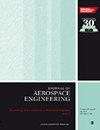Design optimization and power management of a fuel cell-battery fixed-wing electric UAV
IF 1.1
4区 工程技术
Q3 ENGINEERING, AEROSPACE
Proceedings of the Institution of Mechanical Engineers Part G-Journal of Aerospace Engineering
Pub Date : 2023-11-06
DOI:10.1177/09544100231212651
引用次数: 0
Abstract
This study aims for endurance improvement and energy saving by addressing, on the one hand, the design optimization (DO) of a hybrid electric source (HES) consisting of a fuel cell (FC) and a battery, intended for a fixed-wing electric UAV (EUAV) and, on the other hand, the power management (PM) of the sources. The DO employed the particle swarm optimization (PSO) algorithm, which determines the FC power and the battery capacity that offer the sources the least weight; the findings resulted in a weight reduction of 8%; this gain saves a total energy of 90.28 kJ that can extend the “endurance stage” by more than 26 min. Three power management strategies (PMS) are examined: frequency separation (FS), which gives good performance in PM and protects the FC from dehydration by smoothing its response; power limitation (PL) which protects the FC from exceeding its maximum power, and fuzzy logic (FL), which allows for more flexible power distribution between the sources and has the main advantage of controlling the battery state of charge (SOC). A fourth strategy was developed by combining the benefits of these three strategies. This hybrid PMS (HPMS) saves 2% of FC energy compared to the FL strategy. FS and PL save, respectively, 41% and 44% of FC energy, but the SOC can drop significantly, especially for longer missions. The experimental findings, achieved using a laboratory test bench, validate the simulated results obtained from MATLAB/Simulink software, confirming the validity and performance of the proposed HPMS.燃料电池固定翼电动无人机设计优化与动力管理
本研究旨在通过一方面解决由燃料电池(FC)和电池组成的混合电源(HES)的设计优化(DO),用于固定翼电动无人机(EUAV),另一方面解决源的电源管理(PM),以提高续航能力和节能。DO采用粒子群优化(PSO)算法,确定FC功率和电池容量,为源提供最小的权重;研究结果使体重减轻了8%;这一增益节省了90.28 kJ的总能量,可以将“续航阶段”延长26分钟以上。研究了三种电源管理策略(PMS):频率分离(FS),它在PM中具有良好的性能,并通过平滑其响应来保护FC免受脱水;功率限制(PL)保护FC不超过其最大功率,模糊逻辑(FL)允许更灵活的电源之间的功率分配,并具有控制电池充电状态(SOC)的主要优势。第四种策略结合了这三种策略的优点。与FL策略相比,这种混合PMS (HPMS)节省了2%的FC能量。FS和PL分别节省了FC的41%和44%的能量,但SOC可能会显著下降,特别是在更长时间的任务中。实验结果验证了MATLAB/Simulink软件的仿真结果,验证了所提HPMS的有效性和性能。
本文章由计算机程序翻译,如有差异,请以英文原文为准。
求助全文
约1分钟内获得全文
求助全文
来源期刊

CiteScore
2.40
自引率
18.20%
发文量
212
审稿时长
5.7 months
期刊介绍:
The Journal of Aerospace Engineering is dedicated to the publication of high quality research in all branches of applied sciences and technology dealing with aircraft and spacecraft, and their support systems. "Our authorship is truly international and all efforts are made to ensure that each paper is presented in the best possible way and reaches a wide audience.
"The Editorial Board is composed of recognized experts representing the technical communities of fifteen countries. The Board Members work in close cooperation with the editors, reviewers, and authors to achieve a consistent standard of well written and presented papers."Professor Rodrigo Martinez-Val, Universidad Politécnica de Madrid, Spain
This journal is a member of the Committee on Publication Ethics (COPE).
 求助内容:
求助内容: 应助结果提醒方式:
应助结果提醒方式:


